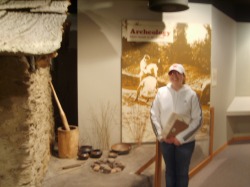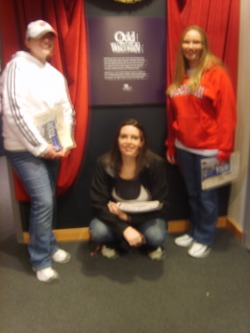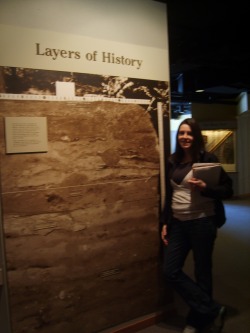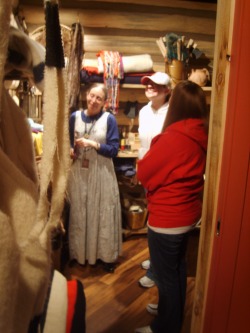Documenting a field trip to the Wisconsin Historical Society Museum
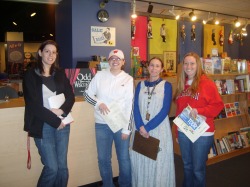
Planning:
As we began to brainstorm places we could go on a field trip regarding schooling, we decided to ask our peers and teachers to see if they had any ideas. A few of our peers talked about going to a school board meeting. Others discussed going and observing different schools such as religious schools, charter schools, ect. Our teacher was the one who told our group about the Wisconsin Historical Society Museum (located at 30 N. Carroll St.) and how they design tours based on the topic you are interested in learning about. We decided on taking a field trip to this museum to learn about how schooling has evolved in Wisconsin. Julie went on the website (http://www.wisconsinhistory.org) and found the number to call to receive more information on designing tours. The person we spoke to was Beth A. Lemke, who is the Museum educator at the Wisconsin Historical Museum. Beth got back to us a few days later and discussed how they design tours and who would be available to be our tour guide. She also discussed with us what our focus was and how she could accommodate this theme. After getting this information, she went to talk to the tour guides and asked them if they could help design a tour about the history of education in Wisconsin for pre-service teachers. Once she found a tour guide she called us to confirm the date we would be visiting the museum and told us the tour would last 45 minutes to 1 hour. She also told us that she would waive the fee since we were pre-service teachers. Ms. Lemke then sent a confirmation email describing who our tour guide would be and the date we would be visiting the museum.
Reflection:
On April 8th, 2009, we toured the Wisconsin Historical Museum. We spent two hours with our tour guide named Dayle. Although Wisconsin education is not a prepared tour already, Dayle created a tour specifically geared for our interests. There was only one exhibit devoted to education, and Dayle spent a significant amount of time with us at this specific exhibit. Even though Dayle did not claim to be an expert in historical Wisconsin education, she had a lot of interesting information. She discussed the Bennett Law and the role of language in early Wisconsin classrooms as immigration resulted in a diversity of languages in Wisconsin settlement areas. We found out that Wisconsin has always placed a huge emphasis on schooling because early immigrants from a variety of European countries, upon their arrival, immediately considered education important and began to build schools. Gayle also told us that Wisconsin was home to the first kindergarten in the country. This kindergarten classroom in the United States was started in Watertown by Margarethe Meyer Schurz and became a model for many kindergartens that followed after it. She also told us that settlement houses (like one in Milwaukee) were influential in historical Wisconsin schooling.
After discussing schooling in Wisconsin, Gayle took us on an abbreviated tour throughout the three floors of the museum, adding in details related to education when relevant. We learned, for example, random facts like that Lincoln logs were invented in Wisconsin by the son of Frank Lloyd Wright. She told us that she prefers to give tours in chronological order. During our tour, Gayle had an interesting interaction with a young student wandering through the museum. She had been discussing the Indians and the fur trade with us when this student pulled her aside to tell her that the politically correct name for this group of people was Native Americans. She spent several minutes discussing the terms with him. Something else that was interesting about this part of the museum was the section devoted to treaties with Native Americans, a topic that Gayle said she avoids at all costs with children because it is complicated even for adults to truly understand.
The layout of the museum is definitely conducive to student tours, and we would all consider taking our students on field trips here. Gayle told us that each day there are about seven or eight groups of twenty five kids each that tour the museum for one hour. Something that we really liked was that pages from the museum's Wisconsin textbook were featured on some of the walls, and Gayle told us that students are frequently excited to recognize the images from their books, as if the things they are studying are actually coming to life at the museum. We were also pleasantly surprised when she used a key to open a door in the museum that students are not normally allowed to enter. Opportunities like this made us feel like we were collaborating with her in the education of children, that she trusted us and considered our roles as teachers extremely valuable. During our tour, she continuously told us stories and gave us pieces of advice about working with students. We found out that speakers from the museum would be willing to come in and speak with our students on most Wisconsin topics if we wanted which would be an incredible resource for our classrooms.
We were definitely satisfied with our trip to the museum, and we wished that we had more time to spend there because we learned so many fascinating facts and collected an abundance of resources. We might have liked to learn more about schooling in Wisconsin, but we definitely left knowing more than we did before we had gone. It was definitely a great learning experience and, though this was the first time visiting for two of us, we have all agreed that it will not be the last time we visit this great museum.
